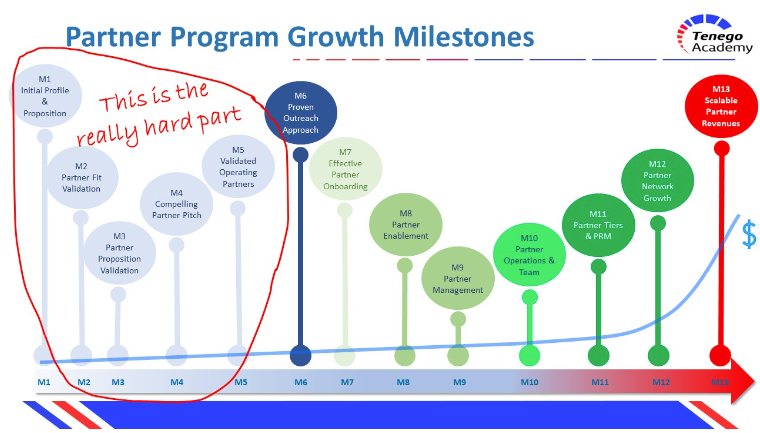For any Tech CEO, having a proactive partner network that drives sales of their product is a fantastically alluring shiny object.
The dream of low-cost customer acquisition too often drives madness. The attitude is often “How hard can partnerships be?”
That mindset is a road to expensive learning that can be avoided.
This over-simplification is evident in small and large companies, new CEOs, and experienced teams.
Here are some of the things to consider early in your partnering journey.

1) Selecting the right partners (partner fit)
Are you targeting the right partner company types?
One very common mistake here is the target partner profile is too simplistic and full of unknown assumptions. A few simple questions highlight the gaps and challenges.
For example, targeting consulting companies that solve related needs, with no thought on whether their solution fits into how the consulting company does business. Consulting companies live on service revenue, so how will your solution help them generate more service revenue?
2) Defining your partner proposition for each partner type
What are you offering your partners that will attract them and motivate them? Why should they bother partnering with you?
A common mistake is that the partner proposition is for revenue share.
This is majorly too simplistic.
Partner companies don’t just want revenue; they want the right revenue for their business. Again, the mistake is too many assumptions.
Our global tech companies have over 20 elements to their partner propositions, and many tech companies think it’s only about revenue share.
3) Committing to a partner enablement plan to help partners
How do you make it easy for your partners to engage the market with your solution?
With the right partner fit, you align with how the partner currently markets and sells, making it easier for them to introduce your material and approach into their business.
The idea is to do more with partners. You want to bring them new capabilities that help them drive engagement for your product, as well as drive new business for them.
A common mistake here is that partner enablement doesn’t go beyond onboarding, and often the onboarding is too heavy upfront on the product and not enough marketing, prospecting, and sales.
Instead of bombarding your partners during the onboarding process, give them just-in-time training. This will help your partners build confidence.
4) Recognising and applying the right capabilities to get started
The regular mistakes here are asking a partner manager to hunt and recruit partners, or assuming that a partner leader with experience knows how to build an entire partner program.
There are different capabilities required in developing your partner program. And they usually don’t exist in one person. Here are some of the things you’ll need to work on:
- Partnering Strategy and Program Development – aligning with the business, high-level strategy dropping down to the execution detail plans and approach
- Partner Management & Enablement – hands-on relationship-driven partner success managers
- Partner Program Operations – to operate the structure and processes in support of the partnering team, working with them and other company functions
- Partner Recruitment – The hunter who drives partner network growth
When and in what quantity are these capabilities required? You’ll need to assess this at each stage of your partnership.
5) Acknowledging the partnering learning journey
How well do you know your list of unknowns in your partnering plans?
The beautiful hockey stick revenue growth curve that comes with partnerships is full of assumptions that need to be validated.
With points 1 to 4 above in mind, ask yourself:
What are the activity streams in your plan that will tackle the assumptions, unknowns, learnings, and validation required at each stage of your partnering journey.
Then determine what pace you can cover these bases and progress your partner program plans.
Partner pros need to learn to slow down. Your goal should be to learn to play rec league before going pro.
Too many tech leaders jump straight to targeting potential global partners, without a validated partner proposition. Targeting the wrong partners can swallow up time in discussions, with the best intentions but without a proper understanding of whether or not there is a partner fit.
TL;DR
- It’s the unknown assumptions that will cost you time and money.
- Don’t move forward until you’ve validated with multiple proof points.
- A small percentage of companies are lucky enough to begin partnering right away; everyone else needs to work at it.
- Keep your expectations realistic for your partner team. Learning partnerships is tough work. It’ll take time to grow your partner program.
- Revenue growth assumptions are nearly always wrong. The learning time for partnerships to work takes much longer than expected.
Donagh Kiernan is the founder and CEO of Tenego Academy. Check out his courses in the ParnterHacker Ed Hub, and connect with Donagh on LinkedIn.
Prefer to listen? Subscribe to our nearbound.com Audio Articles Podcast. Text-to-speech provided by our partner Voicemaker.in.



